With spam filters getting better and better, and stricter inbox placement algorithms, it’s essential to stay up-to-date with the best practices that ensure your emails reach the subscribers’ inboxes. In this article, we’re going to jump into some of the top strategies and techniques to boost your email deliverability, including email authentication, list hygiene, engaging content, and monitoring sender reputation. Let’s dive in!
About our guests
Recently, we had the pleasure of chatting with top experts in email deliverability and marketing automation: Przemysław Depka Prondzinski, Customer Implementation Team Lead at GetResponse MAX, and LB Blair, Head of Deliverability at Email Industries. Together they shared their insights on email deliverability.
Przemysław Depka Prondzinski is the Customer Implementation Team Lead at GetResponse MAX. He has been part of the GetResponse team for more than 9 years. Throughout his career, he was responsible for providing expertise on running successful email marketing campaigns, strategic email marketing advisory, and most recently, onboarding and training new GetResponse MAX customers.
GetResponse MAX operates as an email and marketing automation platform, specializing in driving revenue growth via advanced email marketing, marketing automation, and dedicated support. Trusted by 350,000 brands globally for the past 25 years, GetResponse MAX is a powerful email marketing and marketing automation platform. Curious to learn how it can support your business? Schedule a demo with the team.
LB Blair is the Head of Deliverability at Email Industries. LB has a wealth of experience working with numerous Fortune 100 brands, some sending over one billion email messages monthly. LB strives to deeply understand our client’s businesses, their use cases for email, and their pain points then focuses on engineering email infrastructure and strategies for optimal inbox placement, performance, and reach.
Email Industries is a US-based email solutions provider, offering a range of innovative products and services aimed at helping businesses optimize their email marketing efforts. We help organizations worldwide solve their most challenging email deliverability problems and guard against future disruptions. See how we can support your needs.
Email open rates and deliverability after the Apple Mail Privacy Protection
What you need to know:
- In September 2021 Apple released their now infamous Mail Privacy Projection (MPP) update.
- After the update Apple Mail open rates jumped significantly due to images being cached at send.
- Open rates inflated from 20% being a good rate while now it’s around 30%.
- Open rates have always been a proxy, thus making them directional.
- The important thing is looking at which direction things are trending.
In recent years, one topic that has ignited intense debates among marketers is the impact of Apple’s iOS update on email deliverability. Now that the dust has settled and the data has been analyzed, our Head of Deliverability LB Blair delved into some findings.
Back in September 2021, Apple introduced mail privacy protection as part of its iOS update, specifically targeting users of the Apple Mail client.
Essentially, Apple’s privacy protection features automatically downloading all images in an email sent to users of the Apple Mail client. This triggers an open event, giving the impression that the email has been opened as soon as it landed in the recipient’s inbox.
Initially, there was widespread panic, with many proclaiming the death of open rates. However, as LB stated, the reality is that very little has changed. Open rates have always been imperfect metrics, relying on embedded pixels with unique identifiers to track email opens. They provide a directional understanding rather than precise data on who exactly opened an email.
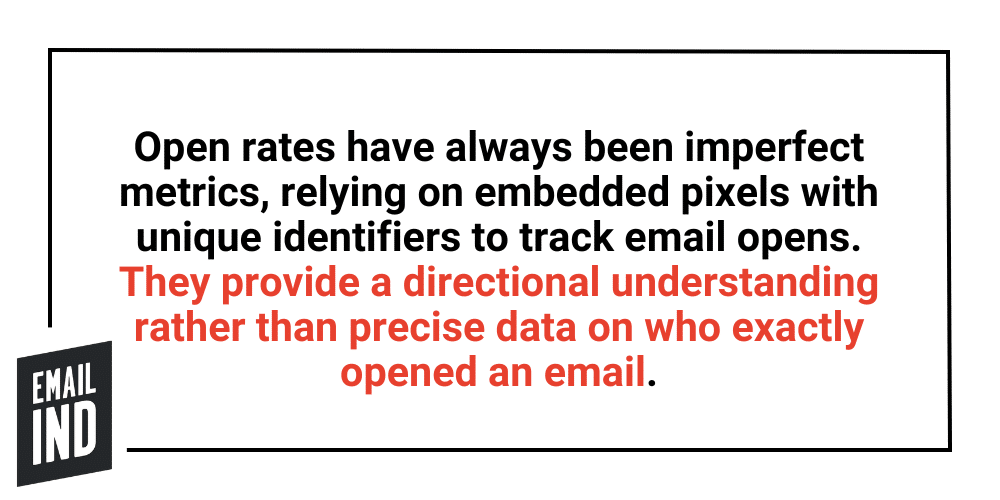
Open rates remain valuable as directional indicators, but the real focus should be on trends and comparing rates across mailbox providers. Significant discrepancies between providers like Gmail, Yahoo, and Hotmail can signal deliverability issues.
Previously, a 20% open rate was satisfactory, but with iOS adoption stabilizing, a 30% benchmark is more realistic. Falling below this threshold suggests potential deliverability problems.
One of the top tips LB Blair shared is to always compare yourself against yourself. Celebrating successes is just as important as identifying areas for improvement. If you’ve experienced a deliverability problem and managed to increase your open rate from 10% to 15%, that’s a 50% improvement. While it may not be the ideal rate, it’s still a substantial achievement worth acknowledging. Rather than solely focusing on what went wrong, take the time to understand what’s going right and replicate those strategies. By recognizing and duplicating your own successes, you can continue moving towards greater achievements in email deliverability.
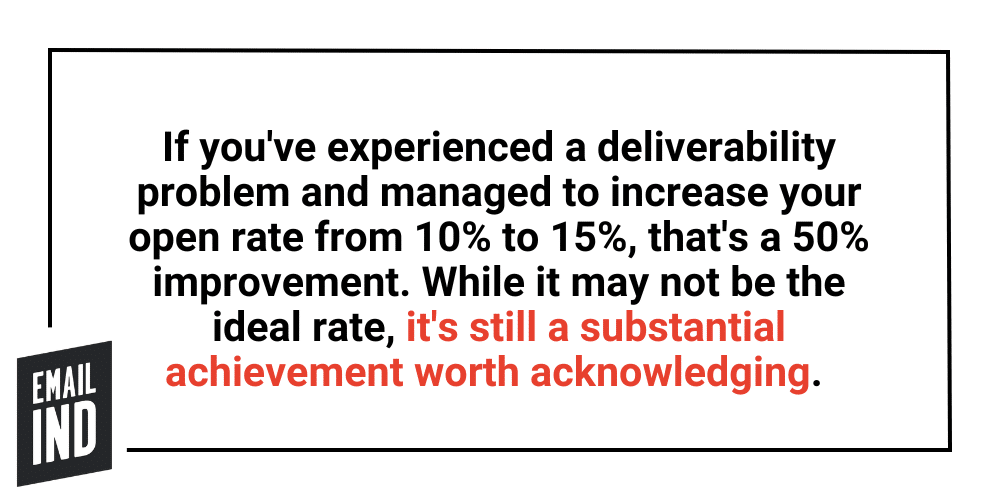
Monitoring and benchmarking your emails
What you need to know:
- Whenever you can, refer to industry reports and benchmarks such as the 2023 Email Marketing Benchmarks report by GetResponse, to understand average open rates, click-through rates, and conversion rates for different industries.
- Compare your own email performance metrics against these benchmarks to assess how well your campaigns are performing relative to industry standards.
- Regularly review and analyze your metrics to identify trends, patterns, and opportunities for optimization in your email campaigns.
Przemysław Depka Prondzinski has been at GetResponse for more than 9 years, so he was able to give the webinar audience lots of invaluable insights. During the session, he highlighted how analyzing industry data and benchmarks is crucial to understanding trends and optimizing performance.
As he says: “You need to regularly review and analyze your metrics to identify trends, patterns, and opportunities”. Analyzing data on a regular basis is extremely important for all email marketers. It helps uncover patterns, identify opportunities, and track progress over time. It also allows marketers to spot any changes in trends and, in turn, quickly react and improve their email marketing campaigns.
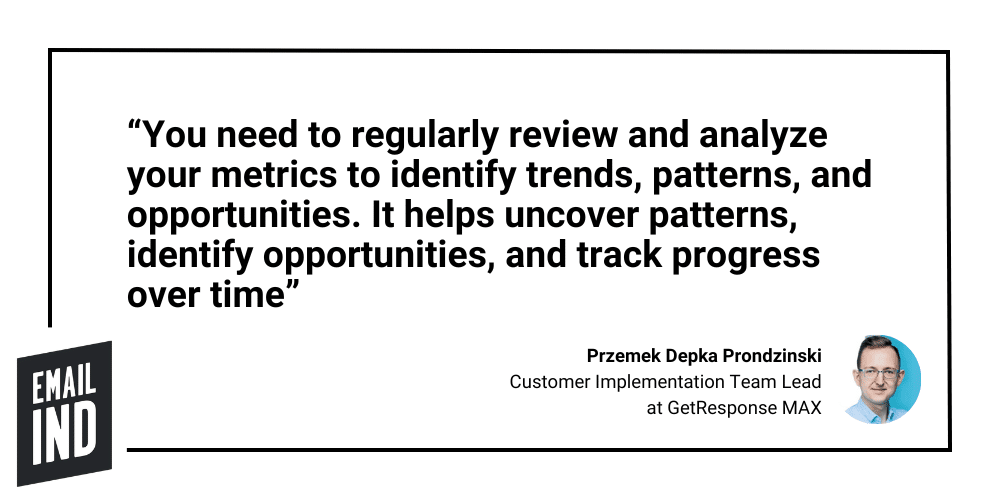
A recent report by GetResponse, for example, analyzed almost 7 billion messages GetResponse customers sent throughout 2022. One of the key findings was the regional performance in terms of open rates and bounce rates. North America stands out with high open rates and click-to-open rates, while Europe follows closely. However, Europe showed a significant decrease in bounce rates with 2.07% compared to North America’s 4.92%. How was this possible?
It can be attributed to European countries’ commitment to adhering to regulations like GDPR by implementing double opt-in for subscribers, focusing on quality content, respecting subscriber preferences, and maintaining list hygiene.
Bounces: like reading your email’s tea leaves
What you need to know:
- Bounces and deferrals can be an early warning sign of a problem.
- You can receive definitive information directly from the mailbox provider about how your mail is being received.
- Many bounce messages contain links to helpful documentation like Gmail and Mimecast bounces.
- The SMTP Field Guide can help interpret those messages.
Analyzing bounce messages is one of LB’s favorite things to analyze. It’s a crucial practice for email deliverability that can provide valuable insights into the success of your email campaigns.
Bounce messages, whether you receive them directly from the platform or through the support team of your software tool, offer a wealth of information that can help you identify and address issues. Even if your bounce rate is below a few percent, it’s important to stay vigilant, especially as your business scales its send volume. Why? As you send more emails, mailbox providers expect higher standards, meaning they become less tolerant of bounces. As LB emphasized, “as you scale, you’re absolutely going to be held to stricter standards because the mailbox providers look at you as a greater risk”.
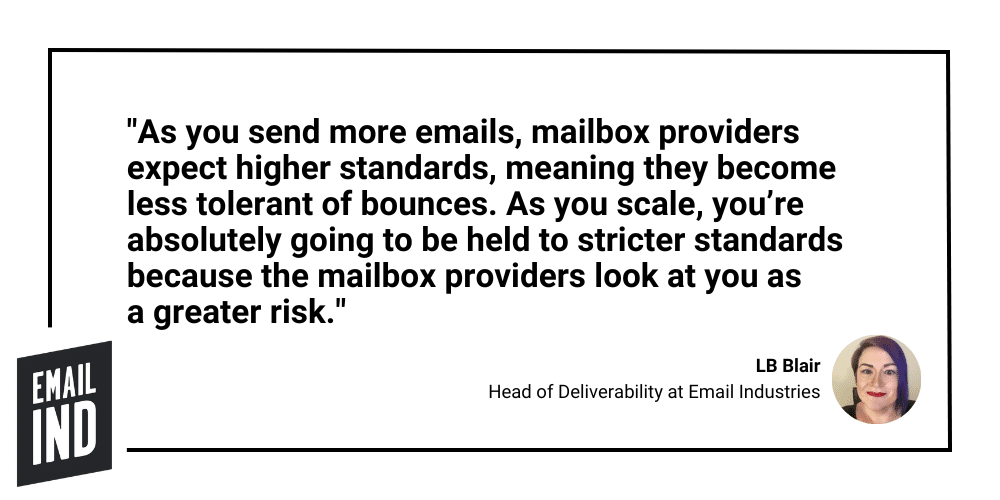
Especially during the warm-up phase, remember to closely monitor all bounce messages. They not only include hard bounces but also soft ones and deferrals, indicating areas that need attention. Bounce messages offer a direct source of truth about how your mail was processed. Oftentimes they include detailed feedback from some providers like Google, or Mimecast. Use this information to implement any improvements to your future email campaigns.
LB also shared a tip on what to do, if you’ve no idea what specific bounce messages mean. Tools like the SMTP Field Guide can help you understand any bounce messages and address specific issues.
List segmentation: improve email deliverability and avoid sending spam
What you need to know:
- Nothing has changed. Sending relevant content to the right audience is crucial for improving email deliverability and avoiding spam. Segmentation is the tool you should use.
- A small decrease in the overall open rate can lead to a significant drop in engagement on specific domains. Therefore, closely observe domain-specific statistics, especially for sensitive domains like Yahoo! or AOL.
- It’s hard to remove some emails from your lists, but it is inevitable because failure to follow best list hygiene practices can lead to a significant increase in spam traps.
When it comes to segmentation, Przemysław is very straightforward. “Without segmentation, you will just send to all of your contacts at once.” and that’s not the approach we want, if our goal is getting to our subscribers’ inboxes.
Sending emails to all of your contacts at once without proper segmentation can result in your messages ending up in spam folders, while the key to achieving the best deliverability lies in sending relevant content to the right audience.
Przemysław recalled a customer success story, where the company switched from shared IPs to dedicated ones, and started their journey with marketing automation. They were only sending the messages to the best contacts, using the most creative campaigns, plus they were A/B testing the subject lines, A/B testing the call-to-action buttons, and adding some gifts to engage the audience. As our speaker admitted, he has never seen better results.
Marketing automation, he says, is like one-to-one communication with your customers. It always looks great in the eyes of Inbox Service Providers. So, when it comes to reputation, think about marketing automation. It can increase your open rates, click rates, and, in turn, positively affect your reputation.
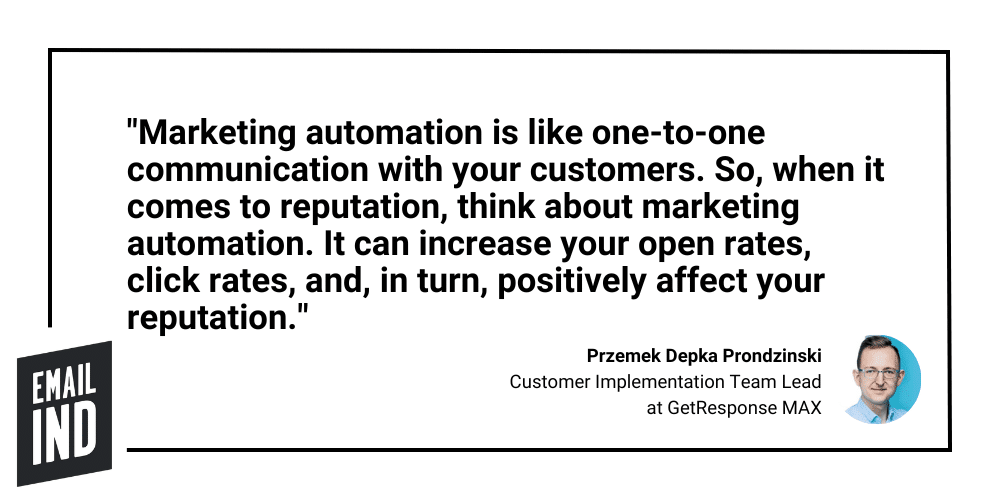
Remember, many ISPs look closely at brands, so it’s especially important to consider many elements of your campaigns, such as what domains you’re sending from in building your reputation. When you make the decision to switch the IP addresses to deliver your messages, but fail to ensure proper authentication of your from domains, you will most certainly raise suspicion of ISPs and jeopardize your reputation. How to avoid it? Try implementing SPF, DKIM, and DMARC. All those can greatly contribute to your reputation management. Once you have taken care of these authentication measures and chosen a compliant tool, you can shift your focus to segmentation and crafting engaging content that will attract your subscribers.
How content quality affects email deliverability
What you need to know:
- HTML errors can make emails look suspicious.
- Insecure (HTTP and not HTTPS) links and image hosting can result in spam filtering.
- Spelling mistakes make messages look like spam, always double check.
- Message file size can impact inbox placement due to storage concerns.
- Hotmail/Office seems to still filter some messages based on keywords in the subject line.
A big part of the science behind email deliverability is content. The quality of your emails is undoubtedly one the most important indicators whether your email campaign is going to be successful or not. LB focused on a few points marketers need to look into.
First off, if you don’t want to look like a spammer, you want to avoid any mistakes both in your HTML code and spelling. Poor grammar is not what your subscribers wish to encounter. As LB points out, “it can look inherently scammy or spammy because scammers and spammers don’t spend a lot of time on their content”. So, if you notice any kinds of typos in your emails, try and fix them as soon as possible.
Another important aspect is security. The prime objective of mailbox providers is to secure their users against email-based attacks, which still represent about 80% or more of all hacking attempts. Malicious internet attacks start with email, so that’s why spam filters are purposefully so hard to get through.
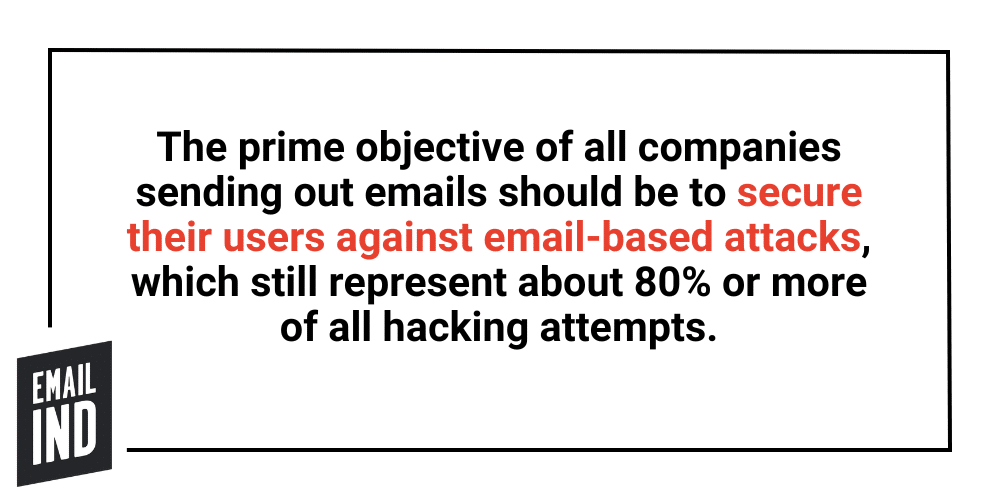
When it comes to email deliverability, LB discussed two more key factors to consider: message file size and avoiding certain practices that can harm your reputation with mailbox providers.
It’s crucial to make sure your email provider offers a user-friendly drag and drop editor or that your email development team produces clean and unified code. Bloated file sizes can be problematic since major providers like Google, Microsoft, and Yahoo store messages indefinitely. Although a hundred kilobytes may seem insignificant, the sheer volume of daily messages can strain their servers.
Additionally, recent examples have shown that Hotmail and Office dislike messages with words in all caps or attempts to mimic correspondence in promotional emails, such as pretending to reply to a message with “Re:” or forwarding it (Fwd:). Trying to trick mailbox providers may provide short-term gains but can severely damage your reputation in the long run.
Regaining the sender’s reputation after it’s been damaged
What you need to know:
- Employ different tactics tailored to specific ISPs, considering their individual blocking mechanisms and preferences.
- Monitor your email performance in real time and be proactive in assessing the situation when encountering poor statistics. React if bounces are higher than 10%.
- It’s better to work on improving a negative reputation rather than changing to a new IP address.
As Przemysław Depka Prondzinski explains, damaging your reputation can happen really fast through trying to achieve quick wins. This often happens when customers start their email marketing efforts aggressively, importing old contacts from their Customer Relationship Management (CRM) systems that were never used for marketing purposes. For subscribers that have never received any communication from a particular company before it may come as a surprise.
How can you recover from a damaged sender’s reputation? It’s essential to monitor your email performance in real time and be proactive in assessing the situation when encountering poor statistics. React right away if your bounce rate exceeds 10%. If you need to improve the sender’s reputation, using specialized email warming services such as Warmy.io can prove to be a strategic move as these services facilitate the gradual establishment of a positive sender reputation by systematically increasing the volume of sent emails over time. By adhering to best practices and following industry guidelines, these services help your emails navigate through spam filters, avoid being flagged as suspicious, and ultimately enhance deliverability rates.
Remember, that high bounce rates can negatively impact your reputation. Instead of changing your IP address, focus on improving your negative reputation through strategic measures.
Q&A session
Q: Can you send from different “FROM” names using the same email and IP, etc.?
Przemysław Depka Prondzinski: Yes, definitely. When you set up your email campaign, you can select different types of “from” email addresses. It can even be the same email address, but with a different display name. What it means is that we can still use the same email address for multiple names. When you set up your account, you can have one main IP address or more if you send high volumes of emails. Then you’ll have a main domain that is assigned to the IP address, if you have a dedicated domain, but you can still have as many different “from” email addresses as you wish. There’s no limit, and it is available in GetResponse.
Q: Is it valuable to mine the alternative contact data bounced back in out-of-office messages?
LB Blair: I would say for bulk or promotional marketing purposes, no, because you are not going to have permission to email those contacts. They’ve not opted in for you. It might be useful for you to have that info, if you’ve been emailing a client contact and you get an out-of-office message that says they’re on maternity or paternity leave or on vacation for a while.However, I would say that’s not a bulk marketing kind of concern.
In general, I’d be concerned, especially in Europe with GDPR, in Canada with CASL, and a bunch of other countries with similar opt-in requirements in the regulations. I would be very averse to opening myself to that risk.
Q: What is the GetResponse strategy for when to remove bounces? Immediately or after several bounces?
Przemysław Depka Prondzinski: That’s a very good question because you need to get rid of those bounces and you need to identify and classify them. We do that part for you automatically at GetResponse, so when we know for sure there is a hard bounce, it is removed automatically. If we are not sure about the hard bounce, we try to deliver it one more time to be 100% sure. When we have soft bounces, you need to look at them from two different perspectives.First of all, whether the soft bounce is happening because of the recipient’s full inbox or some missing parts of the configuration, or the soft bounce is an effect of poor reputation as a sender.If the soft bounces are connected with reputation, we cannot remove those email addresses because it’s not the email address’ fault. It’s the fault of the sender whose reputation is low. The inboxes will not accept any more of your content to the specific email addresses. We try to deliver four times to those soft bounces that are not connected with reputation as a sender.
Conclusion
By consistently applying these six strategies and techniques, you can create targeted and engaging email campaigns, leading to higher open rates, increased engagement, and overall success in your email marketing efforts. As email deliverability remains a rapidly evolving landscape, adopting a proactive approach and adapting to those changing circumstances will ensure your messages resonate with your audience and drive meaningful results.
Curious to learn even more about email deliverability’s best practices by GetResponse MAX and Email Industries? Follow us on social media to get all the latest updates!
Head of Growth at Email Industries

